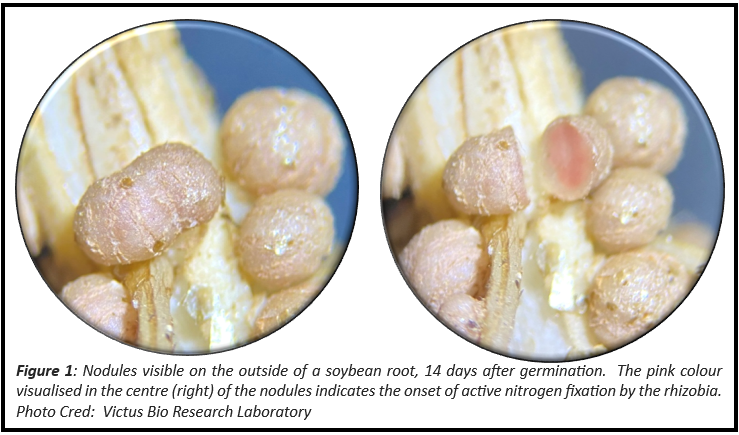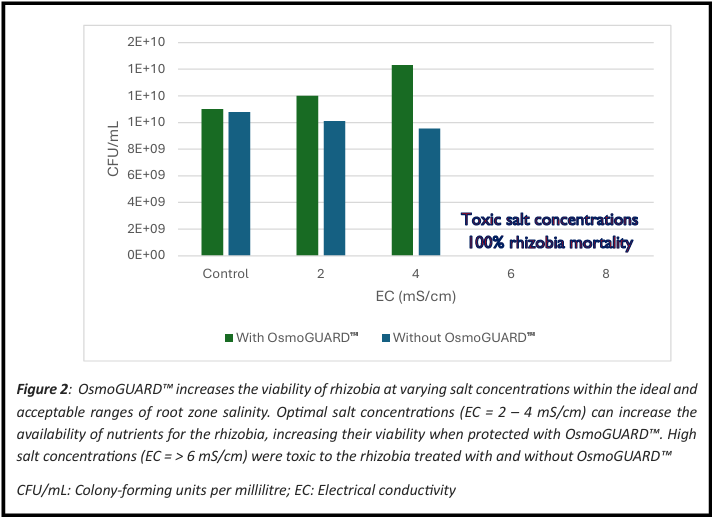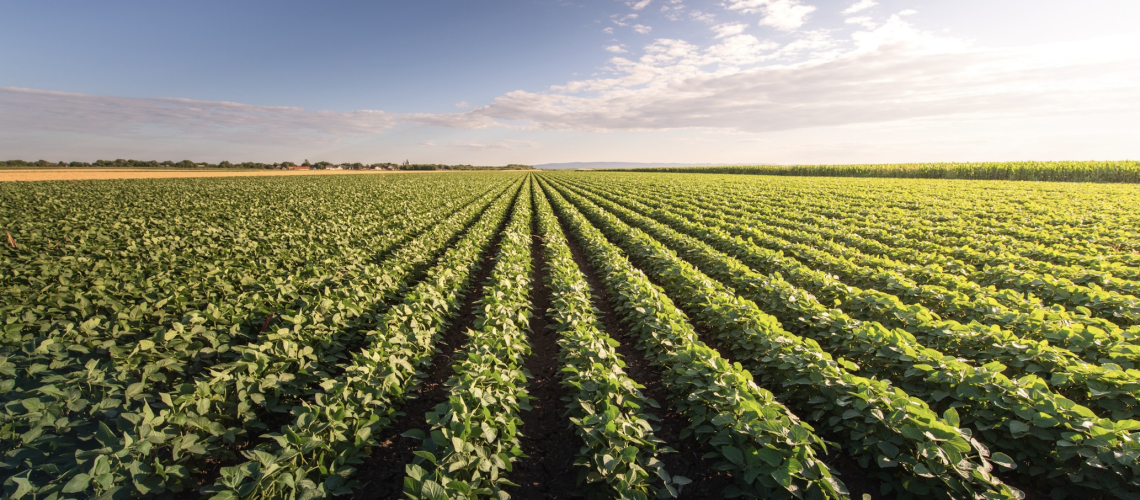Claire Randolph (MSc), Victus Bio, Co-author: Dr Stefan van Wyk, Victus Bio
Soybeans and the underground partner
South Africa’s soybean sector is evolving into a key player in agriculture, with more producers recognising the crop’s value in crop rotations, soil health improvement and profitability. But successful soybean production does not only rely on good seed, timely planting and the right inputs. It also depends on a microscopic partner beneath the soil: Bradyrhizobium.
Despite their small size, these bacteria have an enormous impact on soybean growth and performance. In exchange for sugars from the soybean plant, rhizobia supply nitrogen by tapping directly into the most abundant molecule in the atmosphere – nitrogen gas. This natural process can save producers thousands in synthetic fertiliser costs.
For this partnership to work, the rhizobia need to stay alive and healthy and protected from abiotic and biotic stress factors to colonise the soybean roots and form nodules. This is easier said than done, especially when considering the tough, unpredictable growing conditions often faced by South African producers.
The power of the partnership
Soybeans are legumes and, like all plants, they are not able to utilise nitrogen provided by the atmosphere. Fortunately nature offers a solution to this challenge through a nitrogen-fixing bacterium called Bradyrhizobium japonicum, a species of rhizobia that can form a symbiotic relationship with soybeans (Botha et al., 2004). When soil nitrogen levels are low, flavonoids are secreted by germinating soybean roots to trigger the onset of molecular signalling. Rhizobia close to the roots sense flavonoids and respond by releasing their own signals in the form of Nod (nodulation) factors. These two signals create a cross-talk of molecular signalling between the rhizobia and the soybean, which is a very important step to initiate the
symbiosis that would solve the problem of low nitrogen stress.
Strong molecular signalling between the rhizobia and soybean culminates in nodule formation, whereby the root hairs of the soybean grow around the rhizobia forming nodules that are visible on the outside of the root. Rhizobia are encapsulated in the centre of the nodule, with a pink centre being a good indicator for active nitrogen fixation (Figure 1).

A true win-win
Think of the nodule and the root as two engines that need to work together for nitrogen to fixate. The soybean provides nutrition to the rhizobia in the form of sugars, such as sucrose.
In return, rhizobia deliver nitrogen in the form of ammonia, which is converted by the soybean into ureides to fuel photosynthesis. Thus, a true win-win partnership (Liu et al., 2018)
When the nodule and root engines work together efficiently throughout the symbiosis, soybean can fix about 85 to 150 kg of nitrogen per hectare per year. The result of this partnership is healthier plants, better yields and a significantly reduced need for synthetic nitrogen fertilisers.
The challenge to protect the rhizobia
There is a challenge though: the success of this whole process depends on the viability and performance of the rhizobia. While field conditions often place them under considerable stress, the challenge can be managed effectively with the right tools and techniques.
Soybean producers in South Africa are familiar with the unpredictable challenges and risks associated with soybean production. Variable rainfall, high temperatures, drought and fluctuating soil pH levels are often encountered, combined with the physical demands of seed handling and storage (Hassen et al., 2014). All these factors threaten the viability of rhizobia in the field, making it hard for these tiny microbes to remain viable, let alone perform at their best.
Main stress factors that threaten rhizobia in the field
1. Drought and desiccation
Dry soil conditions can be devastating for rhizobia (Vriezen et al., 2007). These bacteria need a moist environment to survive and move through the soil to the soybean roots. When planting into dry conditions, a common occurrence in parts of the Free State, North West and KwaZulu-Natal, many rhizobia fail to survive long enough to establish a relationship with their host plant.
2. High temperatures
Prolonged exposure to soil temperatures above 35°C can be lethal to many rhizobia strains, especially when combined with dryness (Zahran, 1999). Inoculated seeds exposed to direct sunlight on hot days during planting are particularly vulnerable. Short exposure to extreme heat can also drastically reduce rhizobial survival.
3. Chemical stresses
Fungicide and insecticide seed treatments, while important for protecting the seed, can be toxic to rhizobia (Ramos & Junior, 1993). Compatibility between treatments and inoculants is not always guaranteed and in some cases, rhizobia viability can be significantly affected within hours of application if chemicals are used in high concentrations or incorrectly.
4. UV light exposure
It is not only heat that poses a risk. Sunlight can also cause damage (Daniel et al., 2001). Ultraviolet (UV) radiation can harm the bacterial cells, particularly during seed handling if seeds are left exposed for long periods during planting operations.
5. Soil acidity and salinity
Many South African soils can be either too acidic or have elevated salt levels, especially in areas with a history of over-fertilisation and/or poor drainage (Hassen et al., 2014). These conditions can reduce rhizobial survival in the soil and impair nodulation, even if infection occurs.
The collective consideration of the above challenges indicates that even a premium quality inoculant, whether applied on the seed or in-furrow, may not be enough – unless additional steps are taken to protect the rhizobia.
OsmoGUARD™: Protecting rhizobia on the seed and in the soil
Victus Bio offers a range of biotechnologically advanced inoculants for legumes, including soybeans, namely RX-N™ Soybean, supported by Agri Technovation’s agricultural agronomists
and distributed by Laeveld Agrochem. RX-N™ Soybean contains the widely adapted strain Bradyrhizobium japonicum suited for soybeans. RX-N™ seed treatment offerings are supplied together with OsmoGUARD™ – a specially developed stress-protection formulation to shield rhizobia from environmental and osmotic stress. OsmoGUARD™ increases the viability of rhizobia at varying salt concentrations within the ideal and acceptable ranges of
root zone salinity (Figure 2).
Optimal salt concentrations (EC = 2 – 4 mS/cm) can increase the availability of nutrients for the rhizobia (Singleton et al., 1982), increasing their viability when protected with OsmoGUARD™. With advanced protective polymers, OsmoGUARD™ shields against osmotic and environmental stresses. It also contains molybdenum, an essential micronutrient that stimulates early nitrogen fixation. OsmoGUARD™ ensures that rhizobia attach to the seed surface to keep them close to the emerging roots. It provides specific starter sugars to nourish and sustain the rhizobia from inoculation to germination.

How does OsmoGUARD™ work?
OsmoGUARD™ works by helping rhizobia maintain their internal balance of water and ions under stress, especially in dry, hot, or salty conditions. It functions as a stabiliser to support the rhizobia and help them remain resilient under adverse conditions.
In dry conditions, cells without protection quickly lose moisture, shrink and die. However, rhizobia treated with OsmoGUARD™ are better able to retain water, stabilise their membranes and keep vital proteins functioning. A major concern in the field is how long rhizobia can survive once applied to the seed. OsmoGUARD™ also helps to extend rhizobial survival time on the seed, thereby increasing this survival window, making it possible for producers to better manage the time between inoculation and planting.
Victus products that form part of the RX-N™ offering RhizoGUARD™ is an advanced blend of beneficial Bacillus species formulated with BioProtect™ to support a thriving root zone, enhancing crop performance and improving overall soil health. These Bacillus spp. produce enzymes that degrade compounds in the soil contributing to the release of nutrients normally inaccessible to plants, inadvertently promoting plant growth. The competitive interaction of these Bacillus spp. improves their plant growth promoting effectiveness. These bacteria can act as biofertilizers and/or antagonists (bio-pesticides) or simultaneously as both.
SoluPHOS™ is a premium liquid preparation of growth promoting Pseudomonas species, formulated with BioPromote™ technology to enhance plant growth and improve soil health, supporting crops for peak productivity. The Pseudomonas spp. in SoluPHOS™ produce hydrolysing enzymes which degrade carbohydrates, fat and proteins. These bacteria associate with the plant’s roots and converts glucose to gluconic acid.
Gluconic acid is an organic acid which reduces the pH of the surrounding soil. The reduced pH leads to solubilisation of phosphates bound to metal ion chelates (such as calcium phosphate) and solubilisation of structurally bound potassium in minerals, such as mica, muscovite and biotite. The released phosphate and potassium are plant available. The close localisation to the plant’s roots ensures easy uptake, reducing the need for fertilizer application.
The RX-N™ Soybean range of products
RX-N™ Soybean ULTRA
4 L RX-N™ Soybean, 1 L RhizoGUARD™, 1 L SoluPHOS, 1 L OsmoGUARD™
The elite variant of RX-N™. It is a seed treatment that offers the benefits of OsmoGUARD™ and the biofertilisers RhizoGUARD™ and SoluPHOS™.
RX-N™ Soybean STANDARD
4 L RX-N™ Soybean, 1 L OsmoGUARD™
The most cost-effective option for use as a eed treatment, with the added benefits of OsmoGUARD™.
RX-N™ Soybean IN-FURROW
2 x 4 L RX-N™ Soybean
A soil application to treat up to 20 hectares of land.
Reg no: RX-N™ Soybean (L10868, Act 36 of 1947) / OsmoGUARD™ (L11024, Act 36 of 1947)
References
1. Botha, W. J., Jaftha, J. B., Bloem, J. F., Habig, J. H., & Law, I. J. (2004). Effect of soil bradyrhizobia on the success of soybean inoculant strain CB 1809. Microbiological Research, 159(3), 219–231.
https://doi.org/https://doi.org/10.1016/j.micres.2004.04.004
2. Daniel, R.R. & Santhaguru, K. & Gunasekaran, P.. (2001). Effect of Supplementary UV-B Radiation on Growth, Nodulation and Nitrogen Fixation in Vigna mungo L. and Vigna radiata (L.) Wilczek. Indian Journal of Microbiology. 41, 157-161.
3. Hassen, A., Bopape, F., Rong, I., & Sean, G. (2014). Nodulation efficacy of Bradyrhizobium japonicum strain WB74 on soybean (Glycine max L. Merrill) is affected by several limiting factors. African Journal of Microbiology Research, 8, 2069–2076. https://doi.org/10.5897/AJMR2014.6709
4. Liu, A., Contador, C. A., Fan, K., & Lam, H.-M. (2018). Interaction and Regulation of Carbon, Nitrogen, and Phosphorus Metabolisms in Root Nodules of Legumes. Frontiers in Plant Science, Volume 9-2018.
https://www.frontiersin.org/journals/plant-science/articles/10.3389/fpls.2018.01860
5. Ramos, M & Ribeiro Júnior, W. (1993). Effect of fungicides on survival of Rhizobium on seeds and the nodulation of bean (Phaseolus vulgaris L.). Plant and Soil. 152, 145-150. 10.1007/BF00016344.
6. Singleton, P.W., El-Swaify, S.A. & Bohlool, B. (1982). Effect of salinity on Rhizobium growth and survival. Applied and Environmental Microbiology. 44, 884-90. 10.1128/AEM.44.4.884-890.1982.
7. Vriezen, J. A., de Bruijn, F. J., & Nüsslein, K. (2007). Responses of rhizobia to desiccation in relation to osmotic stress, oxygen, and temperature. Applied and Environmental Microbiology, 73(11), 3451–3459. https://doi.org/10.1128/AEM.02991-06
8. Zahran H. H. (1999). Rhizobium-legume symbiosis and nitrogen fixation under severe conditions and in an arid climate. Microbiology and Molecular Biology Reviews : MMBR, 63(4), 968–989.
https://doi.org/10.1128/MMBR.63.4.968-989.1999





